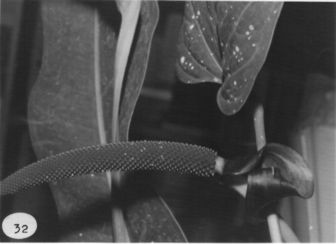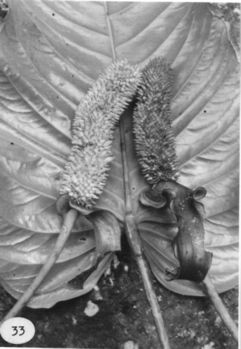





LEAVES spreading; petioles subterete, 26-90 cm long. narrowly and bluntly sulcate; geniculum 2÷4.5 cm long; blades ovate-triangular, moderately thick, abruptly acuminate at apex, broadly to deeply lobed at base, 39-83 cm long, (9-) 13-39 cm wide, broadest in the lower half of the blade:anterior lobe 38÷76 cm long, the margins convex;posterior lobe (5.5-)8-17 cm from apex of sinus to outermost point; sinus arcuate, arcuate with petiole decurrent or hippocrepiform in larger blades, the apex rounded to weakly acute: both surfaces semiglossy; midrib flat at base, narrower midway, more acutely raised at apex above, diminishing and flat toward apex above, convexly raised below; basal veins 2-4 pairs, usually free to base sometimes coalesced 1-2.5 cm, the posterior rib naked, sharply turned up on outer margin; primary lateral veins 13-17 per side. departing the midrib at 50-65° angle, straight 10 weakly curving near collective vein, raised near midrib, sunken toward collective vein above, raised below; interprimary and secondary veins weakly sunken above, prominulous below: collective vein arising from the first basal vein or one of the lowermost primary lateral veins- 3-5 mm from the margin.
INFLORESCENCE spreading to pendent; peduncle terete. 15÷48 cm long, 0.6-1.3 cm diam,, ca. half as long as petioles; spathe coriaceous, dark green, heavily tinged violet purple, lanceolate to broadly lanceolate, 10-18.5 cm long, 2.5-6 cm wide, broadest just above base, strongly reflexed and recurled, cuspidate-acuminate at apex, acute to obtuse at base, inserted at 60-65° angle on peduncle; spadix usually sessile, sometimes stipitate to 1 cm, green tinged violet purple, tapered toward apex, (5-)15.5-28 cm long, 1.2-3 cm diam. at base, 0.7-1.7 cm diam. at apex; flowers 4-lobed, 2.3-3 mm long, 2.8-3 mm wide, the sides sigmoid, 6-11 flowers visible in the principal spiral; tepals matte, punctate, lateral tepals 1.4-1.9 mm wide, the inner margin broadly rounded, erect; pistils pale green, emergent to 1 mm before anthesis, exserted to 3 mm at anthesis; stigmas linear, ca. 0.5 mm long, violet purple with droplets apparent ca. 1 week (during anthesis), drying black as stamens emerge; stamens emerging from the base, the laterals first quickly followed by alternates, exserted on transparent, fleshy, filaments 2-2.5 mm long; anthers 0.9-1.2 mm in both directions, scarcely retracted and held at sides of exserted pistil; thecae ovoid-ellipsoid, slightly divaricate; pollen white.
INFRUCTESCENCE pendent; berries orange (B & K Yellow-red 8/7.5), narrowly ovoid-ellipsoid, acute at apex, ca. 10 mm long; seeds 2, pale yellow-grccn, brownish at apex and base, 4÷4.8 mm long, 2.3-2.5 mm wide, enveloped in an amber sticky substance, briefly appendaged at base. Figs. 32 and 33.
Anthurium colonicum is endemic to Panama and ranges from Veraguas to Code, Panama, and Col—n Provinces from near sea level to 1,150m in tropical wet and premontane rain forest life zones.
The species is a member of section Pachyneurium and is distinguished by its relatively elongate, generally subcordate leaf blades and its frequently stubby spadix with exserted stamens, but especially by its sharply pointed, early emergent pistils, its wavy margined spathe, and its elongate sharply pointed orange berries.
It is most closely related to Anthurium nervatum, which has similar veiny leaf blades, a similarly reflexed purplish spathe, and moderately acute orange berries. The latter differs in generally having the primary lateral veins more numerous (12-30 versus 7-12) and especially by its spathe that is straight to merely twisted but not markedly undulate marginally and by its spadix that has the pistils blunt, emerging with the anthers and tepals that are moderately flat at anthesis. Anthurium colonicum has pistils early emergent and has the tepals turned markedly upward at anthesis. In addition, the stamens of A. colonicum are white to yellowish when fresh whereas those of A. nervatum are orange at anthesis.
 |
 |
Map of Mesoamerican specimens with coordinates
Panama CoclŽ: El Valle Region, 800-900 m, 8.40N 80.7W, 28 Apr. 1982,
Knapp & Dressler 4912 (MO).
Panama CoclŽ: 600 m, 8.45N 80.30W, 7 Feb. 1983, Hamilton & Davidse
2854 (MO).
Panama CoclŽ: El Copé Region,, 1 Feb. 1977, Folsom & Collins
1541 (MO).
Panama CoclŽ: El Copé Region, 900 m,, 9 Apr. 1977, Folsom 2493
(MO).
Panama CoclŽ: El Copé Region, 800-1000 m,, 10 Oct. 1977, Folsom
5820 (MO).
Panama CoclŽ: El Valle Region, 800 m,, 2 July 1978, Hammel 3868 (MO).
Panama CoclŽ: 800-900 m, 8.45N 80.25W, 7 Nov. 1981, Knapp 1946 (MO).
Panama CoclŽ: 600 m, 8.45N 80.30W, 7 Feb. 1983, C. Hamilton & G.
Davidse 2854 (MO).
Panama CoclŽ: 900-1000 m, 8.37N 80.08W, 13 July 1987, Croat 67235 (MO).
Panama CoclŽ: 200 m, 8.47N 80.28W, 17 Dec. 1983, H.W. Churchill, A.
Lier, W.S. Armbruster & A. Herzig 4169 (MO).
Panama Col—n: Portobelo Region, 5-200 m,, 6-8 Apr. 1911, Maxon 5801
(US).
Panama Col—n: Portobelo Region, 50-200 m,, 8 July 1976, Thomas B. Croat
36943 (MO).
Panama Col—n: Portobelo Region, 0-50 m, 09.33N 79.38W, 5 Apr. 1980,
Thomas B. Croat 49786 (MO).
Panama Col—n: Portobelo Region, 1-200 m,, 16 Nov 1975, Davidse &
D'Arcy 10077 (MO).
Panama Col—n: Portobelo Region, 100-230 m,, 1 Oct. 1978, Hammel et
al. 4901 (MO).
Panama Col—n: Portobelo Region, 100-230 m,, 1 Oct. 1978, Hammel et
al. 4925 (MO).
Panama Col—n: Portobelo Region, 100 m,, 21 March 1976, Thomas B. Croat
33519 (B, K, MO, NY, PMA , RSA, US).
Panama Col—n: Portobelo Region, 50 m,, 23 March 1976, Thomas B. Croat
33602 (B, BM, F, M, MO, PMA, US).
Panama Col—n: Portobelo Region,, 22 March 1976, Thomas B. Croat 33640
(MO).
Panama Col—n: 09.40N 79.35W, 5 Apr. 1980, Thomas B. Croat 49812 (MO).
Panama Col—n: < 100 m., 09.27N 79.40W, 19 June 1994, Thomas B. Croat
& Guanghua Zhu 76246 (MO).
Panama Col—n: Río Guanche, 100 m, 09.30N 79.39W, 6 April 1993, Thomas
B. Croat 75183 (CM,MO,NY,PMA,WU).
Panama Panamá: 350 m,, 5 Dec. 1979, Thomas B. Croat 49114 (CAS, MO).